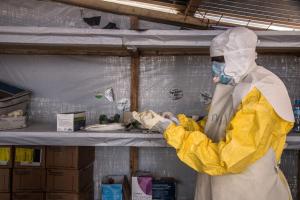Photo: WHO
Almost nine out of 10 people who are infected with the Marburg virus could die.
A tad confused?
With the recent outbreak in Ghana, you may have heard of the Marburg virus disease but do not really know much about it.
Here’s a quick lowdown of what you need to know.
Advertisement
The World Health Organisation (WHO) identifies the Marburg virus disease as a highly infectious hemorrhagic fever caused by a virus in the same family as Ebola — the Filoviridae family. It is spread to people by fruit bats and transmitted through direct contact with bodily fluids of infected people and surfaces.
Illness begins abruptly and many patients develop severe hemorrhagic signs within seven days. Fatal cases usually have some form of bleeding, often from multiple areas like the nose, gums, and vagina. However, there are currently no vaccines or antiviral treatments approved to treat the virus.
The Marburg virus was discovered after two outbreaks occurred simultaneously in Germany (Frankfurt and Marburg) and Serbia (Belgrade) in 1967 — the virus is named after Marburg in Germany. The outbreaks were linked to laboratory work using African green monkeys imported from Uganda.
Advertisement
Since then, outbreaks and sporadic cases have been reported in several countries including Angola, the Democratic Republic of the Congo, Kenya, South Africa, Uganda, Guinea, and more recently, Ghana.
FATALITY RATE ALMOST AS HIGH AS EBOLA
Ebola has a high fatality rate — 25 to 90 percent to be specific — and the Marburg virus disease has a similarly high fatality rate.
According to WHO, the Marburg virus disease has a fatality ratio of 24 percent up to 88 percent — meaning almost nine out of 10 people who have the disease could die. In Angola, for instance, during an outbreak in 2005, 374 people were infected with the Marburg virus. Of this number, 329 people, representing 88 percent, succumbed to the disease.
Advertisement
WEST AFRICA CONFIRMS FIRST-EVER CASE
In August 2021, the WHO confirmed a case of Marburg virus disease in Guinea, making it the first time the virus would be recorded in West Africa. The patient, who died of the disease, was the only confirmed case in the country. In September 2021, Guinea declared the end of the Marburg virus disease outbreak, having recorded no new cases over 42 days.
Almost a year later, in July 2022, Ghana confirmed its first-ever outbreak of the Marburg virus disease. The outbreak has so far has seen four people — including a child — infected. The index cases and deaths were a 26-year-old male and a 51-year-old male, who were rushed to a hospital in the Ashanti region after showing symptoms such as diarrhoea, fever, nausea and vomiting.
Two more cases were later confirmed — the wife and child of one of the index cases. A WHO official said on Tuesday that the child had died, but the wife is still alive and improving. She is currently the only surviving person confirmed to be infected with Marburg virus in Ghana, pegging the current fatality rate in Ghana at 75 percent.
Advertisement
The proximity of Ghana to Nigeria has raised concerns among Nigerians on the likelihood of importation of the virus to the country.
But Ifedayo Adetifa, director-general of the Nigeria Centre for Disease Control (NCDC), has said the risk of importation of the virus to Nigeria has been reduced as the situation is under control in Ghana.
Advertisement
Adetifa added that no case of Marburg virus disease has been reported in Nigeria at the moment.
“Based on available data, the overall risk of both importation of the disease and its potential impact on the Nigerian population is said to be moderate as assessed by NCDC experts and partners given the following: the proximity (same region), high traffic from Ghana and countries that share borders with Ghana, the incubation period of 21 days of the virus, heightened surveillance at point of entry, Nigeria’s capacity to respond to the outbreak in country and the fact that persons with MVD transmit the virus when they become symptomatic, unlike for SARS-CoV-2 that causes COVID-19 that can also be transmitted by infected persons without symptoms,” he said.
Advertisement
Add a comment






